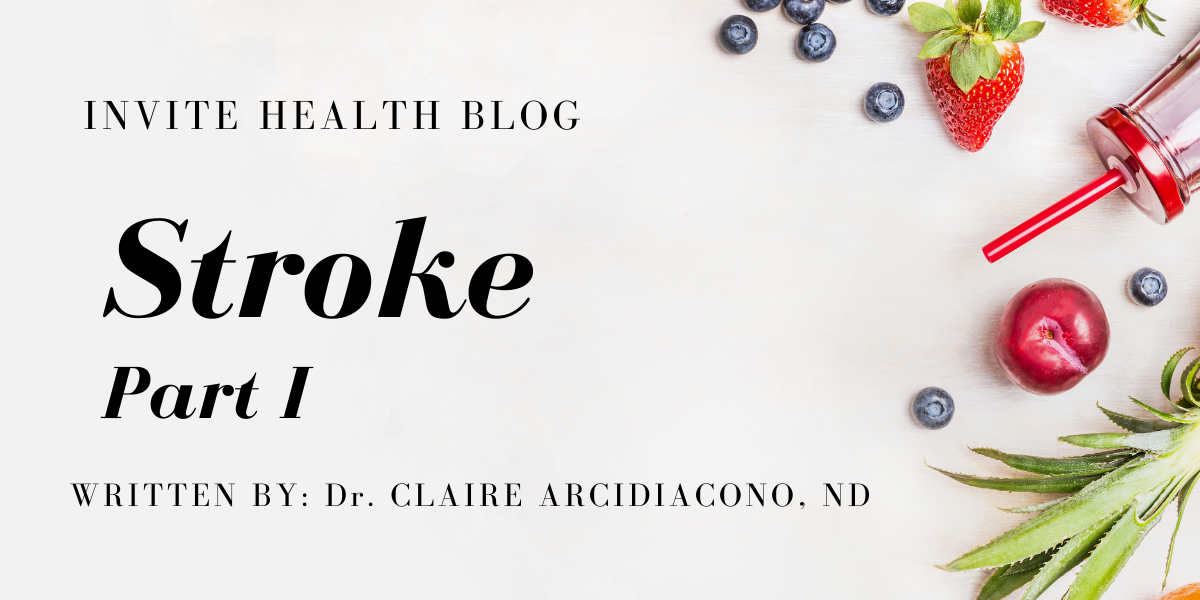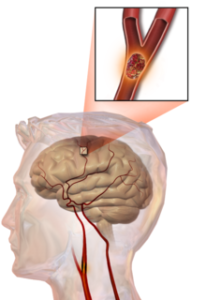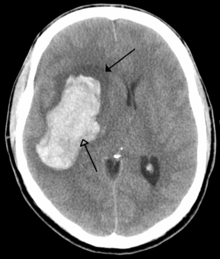Stroke, Part I, Invite Health Blog

Written by: Dr. Claire Arcidiacono, ND
For further questions or concerns email me at [email protected]†
No conversation on brain health would be complete without talking about strokes or in more medical terminology a cerebrovascular accident (CVA). The topic of strokes is quite a large one. In fact, in 2015 stroke was the 2nd most frequent cause of death after coronary artery disease. (1) This means that a huge population will experience the consequences of a stroke – whether it be directly or via family or friend who suffers one. That is why I will be splitting this topic into separate blogs. In this blog we will review what is a stroke? What are the different types of strokes? How is a stroke different from a TIA? In our next blog we will review exactly what causes a stroke? What are the risk factors for having a stroke? What are the most common complications after a stroke? In our final blog on strokes, we will be reviewing the signs and symptoms that you should look out for. We will then be reviewing things that can help reduce our risk factors. Lastly, we will review what supplements can help aid in the healing process after a stroke. †
What exactly is a stroke? A stroke occurs when blood flow to the brain is compromised so that the cells actually die. There are 2 types of strokes, (2) the first is called an ischemic stroke. These types of stokes are caused by an interruption of blood supply to the brain. This blockage or interruption in blood flow can be caused by a blog clot. If you can please picture in your mind the blood vessels in your brain as a river that carries nutrients to your brain. Now imagine a dam stopping that flow, what happens to everything after the dam? Eventually it dies due to a lack of nutrients. That is exactly what an ischemic stroke is. (3) It is death of brain cells because the blood can’t get past the blockage. These blockages can be caused by a thrombosis (local blood clot), embolism (clot that forms elsewhere and travels), shock and cerebral venous sinus thrombosis. These 4 reasons account for 60-70% of ischemic strokes. For the remaining strokes there is no obvious cause, and they are referred to as cryptogenic strokes (4) Please see the picture of an ischemic stroke. † (5)

The 2nd type of stroke is a hemorrhagic stroke. These strokes result from the rupture of a blood vessel or when there is an abnormal vascular structure. In this case, there is bleeding where the rupture has occurred. For example, if the bleeding has occurred in the brain, it is often referred to as an intracerebral hemorrhage, but if it is in the skull but outside the brain it is referred to as subarachnoid hemorrhage. If you recall our anatomy this would be the arachnoid and pia matter of the brain. Going back to our river, instead of a river, picture a long hose that bursts somewhere along the line. You’re standing there with the hose and all of a sudden no water is coming out and you walk along the line only to find a burst hose and water is just building up near the break. Just like the water can’t go further than the break the blood can’t go any further than the rupture. That is why just like in the ischemic stroke the cells die. I would also like to point out that in some cases of hemorrhagic stroke the blood will build up and this will create increased pressure in the spots where the stroke happened. This can also cause damage and can even make blood flow through other vessels become compromised. (6). Please see the attached picture. † (7)

An ischemic stroke can rupture which can lead to a hemorrhagic stroke. This is referred to as “hemorrhagic transformation”. It is unknown how often this occurs. (8) Please see the attached picture so that you can see the difference in the 2 types of strokes. † (9)

There are two main categories of strokes. Ischemic (top), typically caused by a blood clot in an artery (1a) resulting in brain death to the affected area (2a). Hemorrhagic (bottom), caused by blood leaking into or around the brain from a ruptured blood vessel (1b) allowing blood to pool in the affected area (2b) thus increasing the pressure on the brain. †
Now I am sure almost everyone has heard of something called a TIA or transient ischemic attack. The main difference between a stroke and a TIA is how much tissue damage there is. While some people call a TIA a mini stroke there are differences between a stroke and a TIA. A TIA does not cause damage to the brain or permanent disability. However, it is still caused by a blockage to the brain and is thus a huge risk factor for having a stroke that can cause permanent disability. In fact, approximately 1 in 3 people who have a TIA have a stroke. This is especially true in the first 48 hours after a TIA. † (10)
COLLAGEN & THE BRAIN, INVITE HEALTH PODCAST, EPISODE 658>>LISTEN NOW!
I know that this was a lot to take in! Next time we will review what causes a stroke, risk factors as well as the most common complications that are experienced after a stroke. †
REFERENCES
- GBD 2015 Disease and Injury Incidence and Prevalence Collaborators (October 2016). “Global, regional, and national incidence, prevalence, and years lived with disability for 310 diseases and injuries, 1990-2015: a systematic analysis for the Global Burden of Disease Study 2015”. Lancet. 388 (10053): 1545–1602. doi:1016/S0140-6736(16)31678-6. PMC 5055577. PMID 27733282.
- “What Is a Stroke?”. www.nhlbi.nih.gov/. March 26, 2014. Archived from the original on 18 February 2015. Retrieved 26 February 2015.
- “Types of Stroke”. www.nhlbi.nih.gov. March 26, 2014. Archived from the original on 19 March 2015. Retrieved 27 February 2015.
- Guercini F, Acciarresi M, Agnelli G, Paciaroni M (April 2008). “Cryptogenic stroke: time to determine aetiology”. Journal of Thrombosis and Haemostasis. 6 (4): 549–54. doi:1111/j.1538-7836.2008.02903. x. PMID 18208534. S2CID 20211745.
- https://en.wikipedia.org/wiki/Stroke#/media/File:Blausen_0836_Stroke.png
- Abraham MK, Chang WW (November 2016). “Subarachnoid Hemorrhage”. Emergency Medicine Clinics of North America. 34 (4): 901–916. doi:1016/j.emc.2016.06.011. PMID 27741994.
- https://en.wikipedia.org/wiki/Stroke#/media/File:Parachemableedwithedema.png
- Donnan GA, Fisher M, Macleod M, Davis SM (May 2008). “Stroke”. Lancet. 371 (9624): 1612–23. doi:1016/S0140-6736(08)60694-7. PMID 18468545. S2CID 208787942.(subscription required)
- https://en.wikipedia.org/wiki/Stroke#/media/File:Ischemic_Stroke.svg
- https://www.mayoclinic.org/diseases-conditions/transient-ischemic-attack/expert-answers/mini-stroke/faq-20058390


